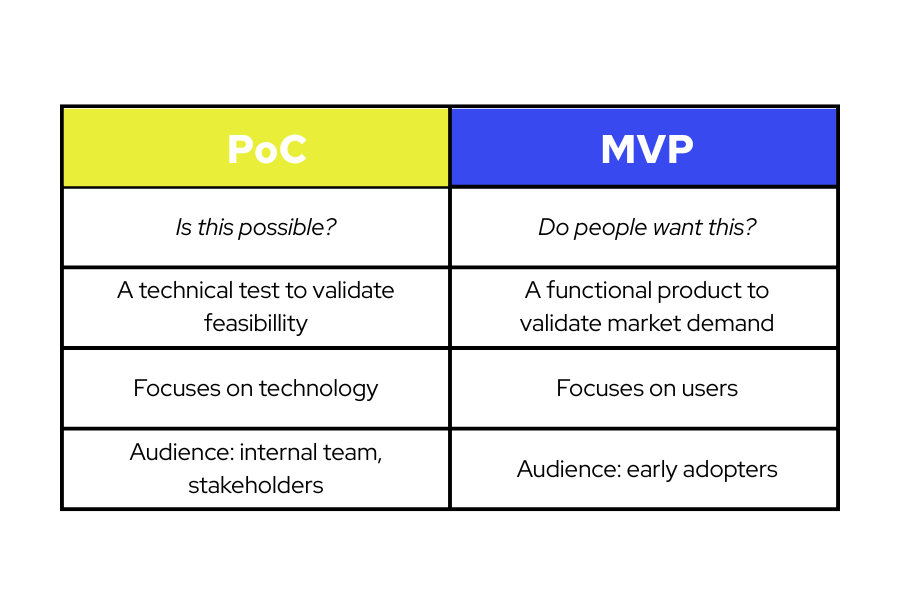Turning innovative concepts into reality in 2025 is a bold, exciting process filled with creative energy, tough choices, and risky moves. Whether you’re launching a startup or steering innovation in a larger company, your first major decision could define everything that follows: Should you start with a Minimum Viable Product (MVP) or a Proof of Concept (PoC)?
This foundational choice shapes how investors view your project, how the market reacts, and, ultimately, how far your idea can go. The harsh truth? Not every innovative idea solves a real problem—and not every startup survives to learn from it. That’s why this decision demands absolute clarity—especially in today’s fast-moving tech world, where the difference between PoC and MVP is often misunderstood.
Understanding PoC: Does Your Idea Actually Work?
A Proof of Concept (PoC) is a technical test of your idea. It asks a critical question: “Is this even possible?” At this stage, design, user experience, and market appeal don’t matter yet. The goal is to prove whether your technology or approach can be built and executed in real life.
If you’re working with new and complex technologies like AI, Blockchain, or IoT, a PoC allows you to validate feasibility before investing in anything market-facing. Whether it’s a small prototype or a technical simulation, the PoC is where you find out if your “aha!” moment belongs in the lab—or the recycling bin.
Real-world example:
Spotify likely began with a Proof of Concept to test whether streaming music directly from servers—without requiring downloads—was technically feasible. Before playlists and premium subscriptions, they had to prove that real-time streaming could actually work.
Understanding MVP: Do People Actually Want It?
An MVP (Minimum Viable Product) is about finding out whether your solution is something users want. Once your tech is proven, it’s time to ask: “Will people use this? Will they pay for it?”
The MVP is a lean, functional version of your product designed to test market demand, gather user feedback, and validate your core value proposition. This is where real-world users interact with your product and help shape its future. The key here is not perfection—it’s learning fast and adjusting based on real use. Think of it as your product’s first public appearance, ready to be critiqued, loved, or ignored.
Simply put:
- PoC asks: “Is this technically possible?”
- MVP asks: “Does anyone actually want this?”
Getting these mixed up—like building an MVP when you really need a PoC—is a common and costly mistake in the startup world.
Real-world example:
Airbnb’s first MVP was a simple website built to rent out their apartment during a conference in San Francisco. It wasn’t fancy, but it worked—and it proved people would pay to stay in a stranger’s home.

The Importance of Precision
Too many startups have rushed to market with a half-baked MVP, only to realize later that they never validated the technology in the first place. Others have overhyped a PoC, mistaking it for a market-ready solution.
The result?
- Lost investments
- Disappointed stakeholders
- Missed opportunities
In an age where information overload and tech hype are constant, precision is your best friend. Choose your path wisely—MVP vs PoC is not just a semantic difference; it’s a strategic one.
Start with the Right Criteria
Before making a move, ask yourself:
- Is this about testing innovative tech like AI or blockchain? → Start with a PoC
- Are your biggest uncertainties around users, pricing, or market fit? → Go with an MVP
This decision protects your team, your timeline, and your budget from unnecessary detours. It also increases your credibility—because nothing beats a startup that knows exactly where it stands. At Sipod, we help startups and enterprises choose the right approach—PoC or MVP—based on their specific product goals.
Real Plans, Not Empty Promises
The real value of both MVPs and PoCs lies in what you learn and how you document it.
- Capture insights.
- Gather real feedback.
- Translate findings into clear, actionable next steps.
Startups that do this gain trust and often attract stronger investment. Enterprises benefit too—every innovation project that’s backed by proper validation adds real value to the company’s long-term strategy.
A Path of Meaningful Progress Through Iteration
Let’s talk about iteration—a word that gets tossed around a lot, yet rarely done right.
Real iteration means:
- Listening to your users
- Learning from your failures
- Evolving your solution continuously
Whether you’re refining your MVP or adjusting your PoC’s direction, iteration is where growth lives. Investors notice teams that iterate well—because it shows agility, resilience, and long-term thinking.
Pitching to Investors: Clear, Honest, and Strategic
When you’re approaching investors or internal decision-makers, tailor your pitch based on your stage.
- If it’s a PoC: Emphasize technical feasibility, innovation, intellectual property, and your proof points.
- If it’s an MVP: Highlight user adoption, market validation, customer feedback, and business growth plans.
Ditch the buzzwords. Investors respect clarity and honesty more than hype.
Looking Ahead: Precision, Clarity, and Purpose
As we navigate through 2025, the innovators who thrive will be those who know how to choose wisely between an MVP and a PoC—and act with strategy, not assumption.
Before you build, launch, or pitch, ask yourself: “What do I need to prove right now?”
The right answer could lead you to an MVP—or to a PoC. Either way, your job is to solve a real problem and create genuine value.
Still unsure whether to start with a PoC or MVP? Let’s talk. Book a free 15-minute consultation and get clarity before you commit.
Tags:





